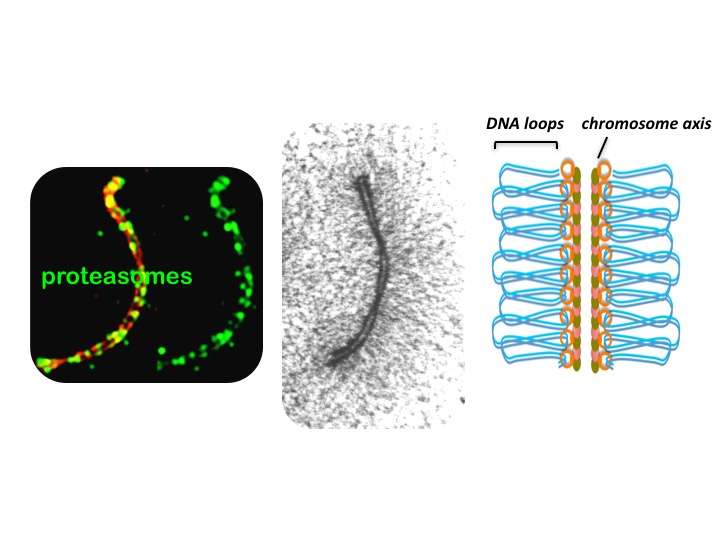New steps in the meiosis chromosome dance

Where would we be without meiosis and recombination? For a start, none of us sexually reproducing organisms would be here, because that's how sperm and eggs are made. And when meiosis doesn't work properly, it can lead to infertility, miscarriage, birth defects and developmental disorders.
Neil Hunter's laboratory at the UC Davis College of Biological Sciences is teasing out the complex details of how meiosis works. In a new paper published online Jan. 6 in the journal Science, Hunter's group describes new key players in meiosis, proteins called SUMO and ubiquitin and molecular machines called proteasomes. Ubiquitin is already well-known as a small protein that "tags" other proteins to be destroyed by proteasomes (wood chippers for proteins). SUMO is a close relative of ubiquitin.
The Meiosis Tango
During meiosis, the chromosomes engage in a complicated, but intricately controlled, dance so that each sperm or egg cell:
- Has half the number of chromosomes of a regular body cell, and
- Exactly one of each of the chromosomes (regular body cells have pairs of chromosomes, apart from the X and Y sex chromosomes)
To achieve these goals, the meiotic cells go through two rounds of division and a number of preceding stages that you can find in any good biology text book.
In preparation for the first division, chromosomes closely associate into matching pairs and then become connected by crossing-over - the breakage and rejoining of chromosome arms. The connections provided by crossovers are important for the accurate distribution of chromosomes. Without crossovers, the wrong number of chromosomes may end up in the sperm or egg cells. Crossing over also shuffles the deck of DNA, making new combinations of the differences between the chromosomes that we inherited from our parents. This is why children look a bit like their parents, but not exactly.

Hunter's lab, and the lab of their colleague Valentine Börner (Cleveland State University) now reveal the central roles of SUMO, ubiquitin and proteasomes in meiosis. Altogether, chromosomes have hundreds of potential crossover sites, but only a few will become actual crossovers. Somehow, the cell has to narrow the large number of possibilities to a few sites, but in such a way that there's at least one crossover per chromosome. Hunter's team found that SUMO, ubiquitin and proteasomes play a critical role in this crossover site selection.
"When you visualize these proteins under the microscope, they accumulate all along the chromosomes, specifically along the chromosome axes, where all the action is occurring," Hunter said.
The chromosome axis is a protein scaffold that organizes DNA into a series of loops. Pairing and crossing over occur between the two axes of each pair of matching chromosomes.
What Hunter's lab discovered is that when chromosomes are paired up, SUMO acts as a brake on the DNA interactions occurring at the hundreds of potential crossover sites. Without this brake, none of these sites form crossovers. "Without SUMO, there are no crossovers and meiosis fails," Hunter said. "We think that stalling the process provides time to select and mature the crossover sites."
Ubiquitin and proteasomes acts on the other side of the process, releasing the brake and allowing DNA interactions to continue. The balance of SUMO and ubiquitin allows just enough crossovers to occur, to help ensure that sperm and eggs get one each chromosome.
The team worked mostly with cells from mice, including mice genetically "knocked out" for genes associated with SUMO, ubiquitin and related proteins in the process. These genes and proteins of course have counterparts in humans, and variants in these genes may be associated with fertility.
More information: H. B. D. Prasada Rao et al, A SUMO-ubiquitin relay recruits proteasomes to chromosome axes to regulate meiotic recombination, Science (2017). DOI: 10.1126/science.aaf6407
Journal information: Science
Provided by UC Davis



















